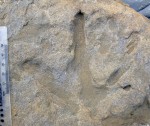 Emory University paleontologist Anthony Martin has discovered 24 dinosaur three-toed tracks left about 105 million years ago on the sand of what was then the South Pole. Now it’s Milanesia Beach in Victoria, Australia, and these are the largest number of polar dinosaur tracks ever found together in one place in the Southern Hemisphere.
Emory University paleontologist Anthony Martin has discovered 24 dinosaur three-toed tracks left about 105 million years ago on the sand of what was then the South Pole. Now it’s Milanesia Beach in Victoria, Australia, and these are the largest number of polar dinosaur tracks ever found together in one place in the Southern Hemisphere.
The tracks were made by several groups of small theropods — most likely ornithomimosaurs, also known as “ostrich mimics” because they have characteristics in common with ostriches — which ranged from chicken to crane sized. The were probably traveling during the summer since they wouldn’t have made tracks had the ground been frozen. The wet sand they walked on compacted into sandstone slabs over millions of years, leaving the footsteps permanently embedded in the surface. At that time Australia was part of the paleogeographic continent of Gondwana along with Antarctica.
The 24 tracks represent 85% to 90% of the known dinosaur footprints in the state, and are considered to be an invaluable resource of information on dinosaur diversity and activity.
“What is significant about dinosaur footprints — as opposed to dinosaur bones or teeth — is the evidence of the presence of dinosaurs. The trace fossils tell us how the dinosaurs were living in the area at the time,” said Thomas Rich, senior curator of vertebrate palaeontology at Museum Victoria in Melbourne and lead author of the paper published today in Alcheringa: An Australasian Journal of Palaeontology.
They might also provide important information about the climactic history of the Earth. The planet was going through a period of global warming 115-105 million years ago when the tracks were laid. The average temperature in the region was 68 degrees Fahrenheit, 10 degrees higher than it is now in Victoria, and back then it was far closer to the South Pole.
Anthony Martin notes: “These tracks provide us with a direct indicator of how these dinosaurs were interacting with the polar ecosystems during an important time in geological history.”
Because sandstone is susceptible to erosion, the research team removed the sandstone slabs with the faintest tracks and brought them to Museum Victoria. Silicone molds will be made for further study.
[youtube=http://www.youtube.com/watch?v=aA78Flyl4jI&w=430]
In a Gondwana da vita?
By I. Ron Butterfly.